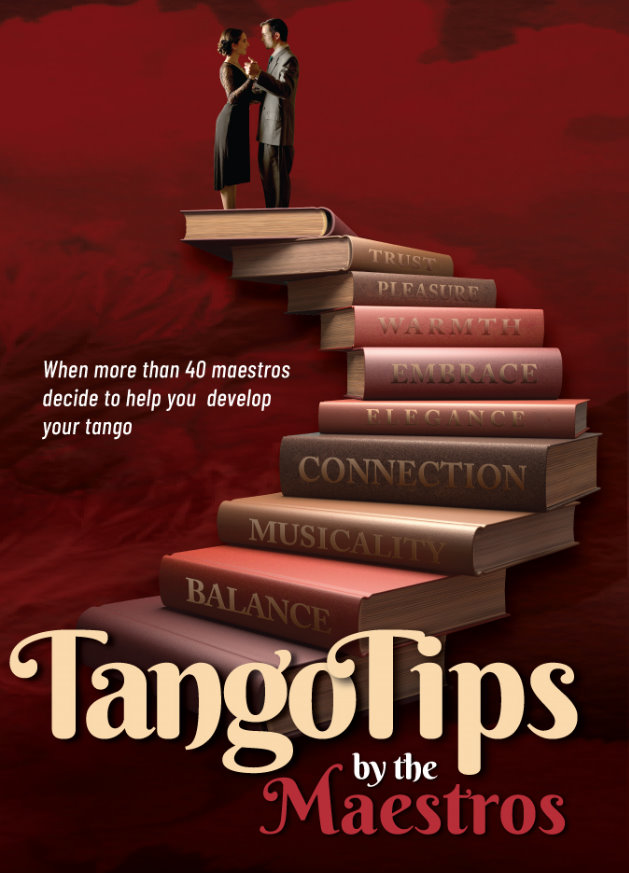
Photo credits: Rui Barroso – Organizer of Tuga Tango Marathon
“I prefer silence. But when I have to talk, I prefer meaning over chatter”
Dimitris
40 icons of tango, judges of the world tango championship, world champions, and experienced maestros came together to create one remarkable book.
A few days ago, I shared the amazing things that happen when you ask the people you dance with two powerful questions:
As described in those posts, asking those two questions can transform your tango.
A lot of people commented something though that made me think.
In plain words they told me:
-Dimitris, why talk? Why ask? Why not just be, silent?
I prefer being silent too.
But when I talk, I prefer meaning over chatter.
If you have been to a tango festival or marathon and 80% of your conversations were about where you come from, what’s your name, and how many days you are staying, then you know what I mean.
But, those people brought up a beautiful topic.
Silence.
So let’s talk silence.
First let’s acknowledge the irony of talking about silence.
.
.
.
.
.
(That was a moment of silence in honor of silence, in case you missed it).
Now let’s break the silence.
I mean literally.
Let’s break it down to its parts and see where that takes us 🙂
There are different types of silence.
More than 20 actually.
Also, there are 4 “areas” that can be or not be in a state of silence.
Those areas are the body, the mind, the heart and the feeling of “I” (which we’ll call “ego” for now).
Choosing the right kind of area and the right kind of silence can create a beautiful experience in tango.
If that feels too philosophical, stay with me, we’ll make it actionable in a while.
I won’t discuss all the 20 different silences.
These are the silences I enjoy:
First, there is the sober silence.
This is the silence that originates when we recognise a particular situation as requiring solemnity and dignity.
Some occasions demand respect through silence.
If I wanted to use my body to express this silence, I would pause the moment the singer starts singing.
If you start looking around the dance floor you’ll notice that a lot of good dancers pay their respect to the singer by making a small pause the first moment (s)he sings.
Second, there is the silence of awareness or alive silence, where we are alert and attentive, perceiving what is going on sharply.
We are paying acute attention.
Using my mind, I silence all other chatter, to simply focus on the creative process that takes place.
Then comes my favourite, the “musical” silence, which means we are absorbed in an activity;
we are doing something which commands and compels us to focus and concentrate on the task at hand, where spoken words have no place.
I love the musical silence, since it seems to be the easiest way for me to silence my ego, the perception of a “self”.
Focusing 100% on the music, something that is outside of us, allows us to get more easily detached from the perception of “I”.
It helps us get to those dances where we feel we are completely lost in the movement and music, leaving our sense of self behind.
Then, there is the silence of listening:
There we are quiet, simply listening to the other person, till that person has expressed what (s)he has to say, and till we have the clarity to respond.
I like to use my heart and body to express this kind of silence.
I simply focus my heart on receiving the feeling and my body on receiving the movement of the person in front of me, waiting for her to express herself, truly and completely; uninterrupted.
When she is done, I propose the next step.
Lastly, there is the silence of peaceful accord.
There we are simply at peace.
This is the serenity that comes from harmony; we don’t speak because there is nothing that need be said that would add anything of meaning.
That’s the end of a beautiful tanda.
Body, mind, heart, ego, all in silence, while we let the last moment go away.
When we simply let go.
I said that I prefer being silent.
In fact, I wish there was a rule that nobody talks during the tanda.
But I also know that this is just my desire, and not everybody comes to tango for the same reasons as me;
Nor others experience it as I do.
And noone can decide what “the rules should be”.
So, when I break the silence, I prefer to ask Why you dance? and What matters to you?
This way a meaningful conversation can start.
When I get the opportunity to be silent though, I take it all in.
What about you? What silence do you like? Please share it in the comments below, I care to read it.
We are building the platform Tango for Good to support projects that use tango for paliative care, alternative therapy, social inclusion, and trauma healing. To help you can:
1) Buy the book Tangofulness: Exploring connection, awareness, and meaning in tango. Its profits fully fund the development and operation of the platform.
2) Buy the book Tango Tips by The Maestros. In its 250+ pages you can find the invaluable advice of more than 40 world class maestros for the price of one milonga. Check it here.
3) Consider supporting us with a small donation on Patreon.
Your support matters.
Dimitris Bronowski
TangoArgentinoFestivals.com

Did you enjoy reading this?
Don’t forget to subscribe using the form above and then check past tangothoughts here.


What a beautiful way to put it… Thank you Dimitris!
I love the silence of not knowing. Not knowing what is coming, and having no way to know what is coming, let’s me relax, let go.
From what you mentioned, I love the silence of peaceful accord. This little pause at the end of the tanda shows me that we created something beautiful together, that we both felt something.
Thank you for sharing your thoughts with us Dimitris!
There is beauty in surrendering Anna, and knowing that you cannot know allows you to do that. Thank you for sharing your thoughts.
I read somewhere recently that the most seductive step in tango is the pause. In your context, that would be “silence of the body”. Some of my most beautiful tango moments where exactly that: a pause. Thank you for sharing this!
“the most seductive step in tango is the pause”. How true… So often we use movement to hide so many things. But in pause, so many more things are visible.
I think there is a silence that you forgot Dimitris 🙂 I love the silence of just sitting and watching the dancers dance. As a follower, I get to enjoy a lot of this 😀 Sometimes it is a blessing, sometimes it is not. But when I choose to be seated and looking at the dancers, I feel blessed knowing that these are all people in moments of pure creation. Oh! And the silence after I have agreed to someone’s cabeceo that I really want to dance with, and he is on the way to my table. Could I call it the silence of expectation? 😀
Why not? 🙂 Silence of expectation it is (anticipation maybe? 🙂 ) They say that people that have booked vacations are on average happier than people who haven’t. The simple anticipation of a happy moment is enough to create happiness. In beautiful symmetry, also remembering about a happy moment brings happiness. 3x of happiness, and all just a decision away, what a blessing the human brain is 🙂
Carolina: I love that last silence you just described. I feel it as silence of anticipation and it continues to that moment when you lift your arms and put them into his and then you wait in that kind of anticipatory silence somehow confident that everything will be just fine and more than that 🙂
“Silence of anticipation” what a beautiful way to put it 🙂
Thank you Snezana
I love the silence…for listening, but not only listening what the other person say or do…but that kind of silence we must made in our mind and body for be able to hear or feel something very soft and quiet , something that is not evident not on the surface. In this case we don`t have to be attentive, or alert, but need to be able to ignore everything common and evident and…at that moment we can catch something deep
Here in your arms where the world is impossibly still
With a million dreams to fulfil
And a matter of moments until the dancing ends
Here in your arms when everything seems to be clear
Not a solitary thing would I fear
Except when this moment comes near the dancing’s end
…it`s something like this
That is beautiful Aliona! Thank you for sharing this!
What a powerful thought (and silence) provoking article. I enjoyed the reflections it brought up for me. The gratitude for the many ways I do express and share silences. The consideration of other ways I might connect better with myself and partners through silence.
Thank you.
You are welcome David!
As I move deeper into the Tango World I learn to appreciate more and more the silence during the tanda. Silence gives you the freedom to concentrate on the music and the wonderfull feeling of movement in aligment with your dance partner. It increases the perception of the embrace and your body very close to another body.
I like the term of “silence of anticipation”, which I also enjoy when I have been invited by a dancer I already have danced with and I am looking forward to a wonderful tanda.
When I have been invited by a person I never danced with I would call the silence between the cabeceo and the first embrace the “silence of excitement”.
Sometimes I also appreciate simple words such as “wonderfull”, “wow”, “nice” etc. They can be said between the songs to give a more direct feedback on how we feel at that moment.
Thank you for sharing that Eva. The “silence of anticipation” is a powerful one. Outside of tango I enjoy it every time I finish booking my next trip 😀 And I will share something here that might be a bit weird: when I have had a wonderful tanda with a woman before, and we are about to dance again, a lot of times I don’t feel the “silence of anticipation”. I rather feel the silence of Dimitris-please-don’t-fuck-this-up-the-expectations-are-high 🙂 :-p Is it just me?
I also have this feeling of “hope it will work the second time as good as the first time”. This happens before the second or third tanda or if I have not danced with this person for a long time. Anyhow each tanda is specific. The fullfillment and connection depends on the music, the previous tanda, how tired we are, and many other factors.
I love the silence at the beginning of the tanda, at the moment right before and during forming the embrace. The pause before beginning to dance. That’s the moment where you connect wordlessly with the other person. If there’s a good connection, you meld your energies together, take a breath, and then you can just surrender to that connection and the music. It’s the best feeling.
“The music is not in the notes, but in the silence in-between” – Wolfgang Amadeus Mozart